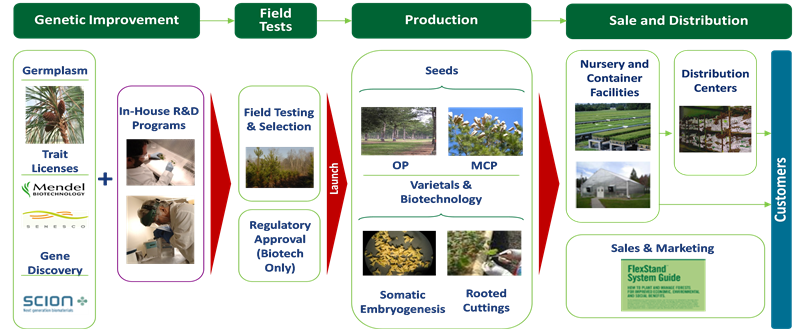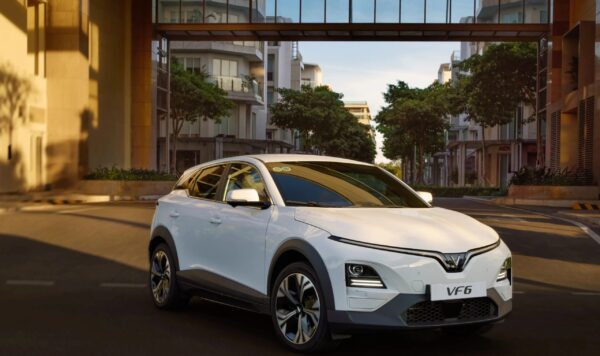Significant presence in scale forestry markets
We have already noted ArborGen’s geographic presence in three distinct regions (four countries). We now discuss the characteristics of its individual markets with more explicit detail on the company’s operational footprint. Firstly, we summarise the strategic objective in each region as follows:
■
US: volume growth with incremental gains in addressable loblolly pine market share through an increasing proportion of MCP and varietal seedling sales;
■
Australasia: volume growth in an expanding New Zealand radiata pine market, at least maintaining market share with stable volumes in Australia after small near-term increases; and
■
Brazil: deeper market penetration; significant increase in volume and addressable market share in growing eucalyptus segment and expansion in smaller pine species segments.
ArborGen has established operations and sales networks in each of these regions as shown in Exhibit 5.
Exhibit 5: ArborGen operational footprint
|

|
|
|
The US is ArborGen’s largest market, accounting for almost 80% of its total annual seedling sales. The above graph shows that its operations here are spread across 10 states located in the south and south-east of the country, mapping directly with the primary loblolly pine growing region. In New Zealand, radiata pine accounts for c 90% of plantation forests; the largest are on the North Island where ArborGen has a stronger presence, but it is now represented on the South Island also. In the US and Australasia, ArborGen operates substantially from owned orchard and nursey sites, with some leased land also. Lastly, the company’s Brazilian head office and only nursery are both located in Sao Paolo state; its nursery and field trials partner sites for both eucalyptus and pine are substantially located in the south and south-east of the country.
Forestry plantations in ArborGen’s active regions in the US and in New Zealand are substantially privately owned and independent, including family and institutional investors (eg forestry REITs), with a small number of larger, integrated forestry companies. In contrast, Brazil has more significant corporate ownership among companies securing industrial supply for pulp and paper, and energy generation. The larger corporate players typically have internal tree improvement activities and are not considered part of ArborGen’s immediately addressable market. Otherwise, there are a limited number of large, independent competitors.
1.
US – migrating up the value chain
As widely reported, the US economy is considered to be robust at present and the OECD projects GDP growth approaching 3% in 2018 and 2019. Tax reforms have benefited the economy and a rising interest rate scenario is now priced in by financial markets. The southern states are known as the ‘wood basket’ of the country, having sizeable producing plantation forests. The primary markets served (being the construction and pulp and paper industries) are cyclical, with annual activity influenced by pricing and exchange rates. The forestry sector has a longer-term horizon and has been receptive to the adoption of advanced seedling types to enhance productivity. The housing newbuild cycle is favourable currently and rising timber prices are beneficial for plantation owners. The US is ArborGen’s largest market and accounts for around two-thirds of revenue currently.
Scale market with substantial private ownership: The Southern Forest Futures Project published in 2013 declared that, following a significant divestment of plantations by the forest products industry up to 2008, 86% of the forest area in the south – some 200 acres/80m hectares – belonged to private landowners. At that time, two-thirds of this private estate was owned by families and individuals, with most of the rest accounted for by companies (including wood products businesses and financial investors such as timber investment management organizations (TIMOs) and REITs. Planted pine forests account for c 19% of southern forest land (39m acres/c 16m hectares in 2010), which straddles family/individual and corporate ownership and is a reasonable proxy for the market size. Loblolly pine is understood to be the dominant species among this planted forestry estate. Planted lobolly trees in this area have a growth rotation of 25-30 years and the new planting activity is driven most obviously by harvesting rates, but also owner profitability (with prevailing market prices a key factor) and perceived long-term industry requirements.
Established uses in industrial markets: We do not have up-to-date data to show current end-market demand, but the two primary markets for softwood grown and harvested in the US southern states are housing and construction for saw logs, and the pulp and paper industry for pulpwood.
■
Timber and wood products are used in housing markets, both the newbuild (including structural timber framing, especially in single family homes) and remodelling (eg interior finishing products) segments. Strength, uniformity and appearance are all important requirements that advanced seedling plantations are capable of servicing in volume. Loblolly pine is also used to make panel products, posts and poles, pallets and crates.
At the end of June 2018, US housing starts (NAHB data) were running at a seasonally adjusted annual rate of 1.17m new homes in aggregate, of which 0.86m were single family dwellings (both of which were lower than seen in Q417 but well above their respective lows of 0.55m in 2009 and 0.43m in 2011 respectively). Projections are for total new home starts to increase to above 1.3m for the year as a whole, rising further in the next two years, with the single-family homes component increasing in the next two years to over 1m in 2020. Both of these levels are in line with the long-term average annual rate since 1980. The latest Harvard LIRA report notes a rising growth in remodelling spend (not all of which would be timber-related) since the beginning of 2016 and projects the current annual rate of c 7% to be at least sustained to the middle of 2019.
■
Pulpwood markets are chiefly split between the pulp & paper and biomass energy industries. Loblolly pine is the dominant plantation species in the US south and, according to the US Department of Agriculture (USDA), softwood in total accounted for 78% of total southern pulpwood production in 2016 (c 134m green tonnes). The US is the largest pulp & paper producer globally and is also a significant importer. This industry uses both soft and hardwood pulps depending on the product being manufactured reflecting different fibre characteristics. Moreover, the genetic make-up of the wood has significant bearing on the pulping process and associated costs. For example, lignin is extracted in the conversion to pulp and, hence, reduced lignin levels reduce intermediate manufacturing costs. Advance seedling development, identifying and breeding reduced lignin seedlings, is a value differentiator. Where this can be combined with faster growth characteristics – improving the yield of juvenile trees at the thinning stage – the benefit is amplified. Biomass energy production facilities have grown dramatically in the south in the last 10 years (to c 9.2m tons annual capacity, primarily in wood pellet form4). Historically, forest and mill residues were the primary sources of material for wood pellets but softwood pulpwood has become the largest supply source. Exports account for well over half of wood pellet production in the south with European industrial power generation a particularly larger consumer, whereas domestic market demand is influenced by the relative pricing of competing residential heating energy sources.
ArborGen’s presence in the south-eastern US derives from its former JV investors, International Paper and Westvaco. It now has seven active nursery operations across five states (Texas, South Carolina, Georgia, Alabama and Arkansas), regional seedling sales offices and a number of seed orchards and field trials. It sells to most of the largest plantation owners and TIMOs in the US south, typically via multi-year contracts with a long tail of others. Loblolly pine is the primary species sold, with smaller amounts of other pine species. Its strategy is to grow volumes and market share – further consolidating its leading supplier status – through the supply of an increasing proportion of MCP and varietal seedlings. ArborGen had previously undertaken research and development of GM freeze-tolerant eucalyptus seedlings in the US, but is not currently actively doing so.
Sizeable addressable market even allowing for integrated players: Using Forest Economic Advisors LLC analysis, Rubicon management estimates that total loblolly seedling annual demand is in excess of 850m currently (of this c 700m represents the addressable market) and c 1bn in the mid-cycle phase.
We are not aware of any other large, independent suppliers of loblolly pine with the breadth of ArborGen’s field operations or integrated research and development activity. State forest agencies appear to offer seedlings as an adjunct to their own forestry management activities, but we believe that their seedling range offered is more limited relative to ArborGen. There are two large quoted and integrated forestry companies – Weyerhaeuser (NYSE:WY) and Rayonier (NYSE:RYN) – which are both timberland REITs and meet their own seedling needs internally, as well as supplying some to third parties. Consequently, we believe that these companies are not currently considered to be part of ArborGen’s addressable market.
2.
Brazil – building market share
After two years of negative GDP performance, Brazil returned to growth in 2017 and the OECD expects improving y-o-y progress in both 2018 and 2019. The Brazilian forestry industry is one of the largest in the world with favourable climatic conditions, and is the world’s largest producer and exporter of hardwood pulp. ArborGen has had a presence in the country for 14 years now and is targeting growth in both eucalyptus and pine seedling volume and market share.
Scale market with strong industrial ties: According to the Brazilian Industry of Planted Trees (IBA) Report, there are c 7.8m hectares of plantation forestry in the country that is recognised as being a global leader in productivity with relatively short rotation periods (from initial planting to harvesting). Of the total, 5.7m (c 73%) is eucalyptus and 1.6m (c 20%) is pine species. The eucalyptus plantation area is up almost 16% from 2010 to 2016, while the aggregate pine plantation area is down by c 10% over the same period. The majority of these plantations are found in the Atlantic Coast and other southern states, and both species have reputations as plantation productivity leaders globally.
Primary domestic markets have shaped the ownership structure of these plantations as industrial customers secure process raw materials. Among these, the pulp and paper sector owns 34% of the total plantation area with 14% by the steel industry (using charcoal as fuel) and a further 10% by wood product producers. Export market demand is important in these sectors:
■
Pulp – second largest global producer (69% of production is exported).
■
Paper – eighth largest global producer (20% exported).
■
Wood panel products – eighth largest global producer (14% exported).
Around one-quarter of lumber produced is also exported. Hence, the Brazilian plantation forestry industry has scale in a global context and is an important contributor to domestic GDP, while also having a positive trade balance overall in these products. The remaining plantation ownership is largely accounted for by independent operators at 29% and financial investors 10%.
Building a Brazilian business: ArborGen opened a Campinas R&D office in 2004 to run long-term GM eucalyptus field trials focused on the pulp and paper industry. In 2013, ArborGen began production and sales of conventionally pollinated (ie non-GM) eucalyptus varietal seedlings following an exclusive licence agreement with International Paper. (This corporate relationship was extended to include IP’s eucalyptus germplasm library in 2017, as noted earlier.) ArborGen’s strategy in Brazil is to sell to the non-integrated companies that do not have active tree breeding programmes, and which otherwise would be limited to planting only readily available commodity seedling products. In 2017, ArborGen produced and sold c 58m varietal seedlings, of which c 50m were eucalyptus and c 8m were pine species. We understand that annual gross market demand is currently c 600m, of which 300m is considered to be addressable (ie independent, non-integrated forestry companies).
FuturaGene (formerly AIM-listed, acquired by Suzano Pulp & Paper in 2010) is considered to be a competitor in GM eucalyptus biotech development. It received regulatory approval for one specific trial deployment in Brazil in 2015 but, to date, we do not believe the company has commercialised those seedling products. ArborGen has been active in research and development in this area including field trials, but is yet to seek regulatory approval status for commercial deployment of any of its biotech products and we believe it is unlikely to do so over our estimate horizon. The general development of GM forestry feedstocks has been contentious and challenged by environmental groups, particularly in the Americas.
3.
Australasia – NZ planting activity stepping up
New Zealand has seen good GDP growth in recent years; the OECD projects solid 3% growth in both 2018 and 2019 (and similar economic progress in Australia), consistent with the rate achieved in 2017. New Zealand has a slightly smaller commercial plantation area than Australia, but it accounts for over 80% of regional revenue. Forestry is the country’s third largest export earner and is about to enter a significant and extended period of harvesting and re-planting, we believe.
Important NZ industry: According to the New Zealand Forest Owners Association the country has 1.7m hectares of plantation forestry, the vast majority of which (1.5m hectares or 90%) is radiata pine. Over 90% of these forests are owned by the private sector. As a measure of annual activity, provisional estimates for 2017 suggest that c 47,000 hectares were planted with radiata pine seedlings in the year, largely in the form of re-planting harvested areas (with just 4,000 hectares of new land). While there may not be a full correlation, 48m radiata pine (of c 51m total) tree stock sales were made, which was slightly down on 2016. As a rough rule of thumb, this indicates a planting ratio of c 1,000 seedlings per hectare.
To provide some context, annual radiata pine tree stock sales have been in the 45m–50m range for the last five years, with a post-2003 high and low of c 65m (2012) and c 29m (2006) respectively. Within these annual sales figures, it should be noted that the proportion of control pollinated seedlings has increased. With the exception of the 2005-10 period, total species annual re-planting rates have trended gently higher since 1991 from c 21,000ha to c 49,000ha seen in 2017. New planting activity has been more volatile; it spiked up in the early to mid-1990s – coinciding with the sale of NZ government forestry interests to the private sector – reaching a peak of almost 100,000ha in 1994 before slipping below 10,000ha in 2005, where it has largely remained since. Given that radiata pine is the dominant species, we think it reasonable to take the above re-planting profile as a proxy for this species.
Significant increase in activity on the near horizon: As radiata pine has a 25- to 30-year growth rotation, this means there is now a significant volume of trees in the 16- to 25-year-old age category approaching maturity/harvesting age. Subject to prevailing log prices, this indicates that plantation owners are set to harvest above average levels of trees and receive above average revenue levels. Typically, one would expect rising tree stock sales and replanting activity to follow. This coincides with a new NZ government One Billion Trees initiative, targeting the planting of one billion trees in the 10 years to 2027. The facilitators for this will need to be put in place and include some financial assistance for smaller plantation sizes. We are not aware of any specific species targets at this stage; while there is an inference that other species are to be encouraged, radiata pine must form a significant proportion of the uplift. Referring back to historic planting activity, the implied average annual planting rate sustained over 10 years is equivalent to the generational peak in 1994. Of necessity, there will be a two- to three-year ramp-up period such that the annual peak during this 2018-27 period will be higher still, if successful.
Leading market player, well positioned for growth: ArborGen sold c 19m seedlings in Australasia in FY18, of which c 80% were in New Zealand and radiata pine. This represents around one-third of the total species tree stock sold in the country and was serviced from the company’s six nursery operations. Competition appears to come from a number of regional nursery suppliers of seedlings, perhaps with a narrower technology offering compared to ArborGen. There is also likely to be some larger integrated forestry players that meet seedling requirements internally, but we are unable to quantify this.





















